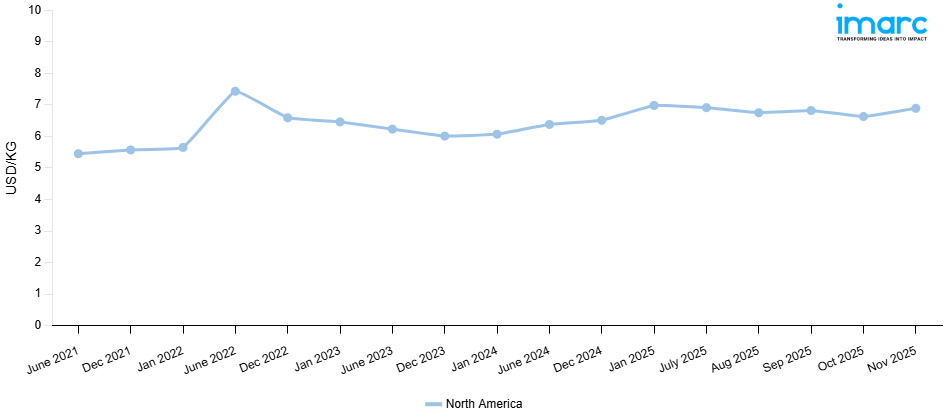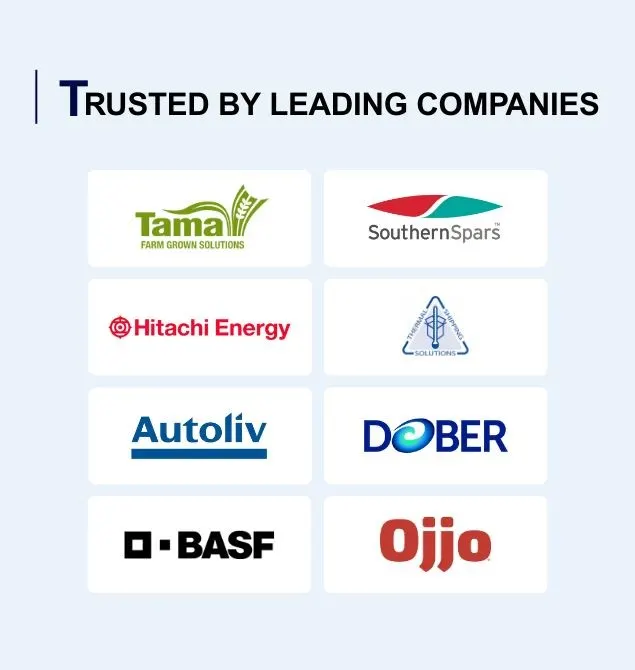
Titanium Prices, Trend, Chart, Demand, Market Analysis, News, Historical and Forecast Data Report 2025 Edition
Titanium Price Trend, Index and Forecast
Track real-time and historical titanium prices across global regions. Updated monthly with market insights, drivers, and forecasts.
Titanium Prices November 2025
| Region | Price (USD/KG) | Latest Movement |
|---|---|---|
| North America | 6.89 | 3.9% ↑ Up |
Titanium Price Index (USD/KG):
The chart below highlights monthly titanium prices across different regions.

Get Access to Monthly/Quaterly/Yearly Prices, Request Sample
Market Overview Q3 Ending September 2025
North America: Titanium prices in North America increased modestly as the titanium price index reflected steady demand from aerospace, defense, and medical industries. Procurement activity strengthened on the back of robust aircraft manufacturing schedules and ongoing defense sector requirements. Supply availability remained adequate, though high energy and production costs supported firmer pricing. Additional demand from industrial applications, including chemical processing and automotive components, further contributed to the positive momentum in the regional titanium market.
Titanium Price Trend, Market Analysis, and News
IMARC's latest publication, “Titanium Prices, Trend, Chart, Demand, Market Analysis, News, Historical and Forecast Data Report 2025 Edition,” presents a detailed examination of the titanium market, providing insights into both global and regional trends that are shaping prices. This report delves into the spot price of titanium at major ports and analyzes the composition of prices, including FOB and CIF terms. It also presents detailed titanium prices trend analysis by region, covering North America, Europe, Asia Pacific, Latin America, and Middle East and Africa. The factors affecting titanium pricing, such as the dynamics of supply and demand, geopolitical influences, and sector-specific developments, are thoroughly explored. This comprehensive report helps stakeholders stay informed with the latest market news, regulatory updates, and technological progress, facilitating informed strategic decision-making and forecasting.
Titanium Industry Analysis
The global titanium industry size reached USD 21.78 Billion in 2025. By 2034, IMARC Group expects the market to reach USD 33.26 Billion, at a projected CAGR of 4.82% during 2026-2034. Growth is primarily driven by the rising use of titanium in aerospace and defense sectors due to its high strength-to-weight ratio, as well as expanding applications in medical implants, chemical processing equipment, and automotive components. Increasing focus on lightweight and durable materials in industrial and consumer markets further supports titanium’s long-term demand outlook.
Latest developments in the titanium industry:
- July 2025: ATI Inc. and Boeing extended and expanded their long-term agreement for titanium products. ATI will supply high-performance titanium materials, including high-strength alloys and flat products such as sheets and plates, to support Boeing’s narrowbody and widebody aircraft programs.
- June 2025: ATI brought online a new facility in Pageland, South Carolina to produce titanium alloy sheet for aerospace use. The facility can roll ultra-thin titanium sheets and will supply components for airframes under a multi-year deal with Airbus.
Product Description
Titanium (Ti) is a strong, lightweight, and corrosion-resistant metal with an atomic number of 22. It is extracted mainly from minerals such as ilmenite (FeTiO₃) and rutile (TiO₂) through the Kroll process. Titanium is known for its exceptional strength-to-weight ratio, making it a critical material in aerospace and defense applications, particularly in aircraft structures, jet engines, and naval equipment. Its excellent biocompatibility enables its use in medical implants, surgical instruments, and prosthetics. Additionally, titanium is widely applied in chemical processing industries for equipment requiring resistance to high temperatures and corrosive environments. Its alloys are also used in automotive, sports equipment, and consumer electronics. Due to its combination of lightness, durability, and resistance to extreme conditions, titanium has become a strategically important material in modern advanced manufacturing.
Report Coverage
| Key Attributes | Details |
|---|---|
| Product Name | Titanium |
| Report Features | Exploration of Historical Trends and Market Outlook, Industry Demand, Industry Supply, Gap Analysis, Challenges, Titanium Price Analysis, and Segment-Wise Assessment. |
| Currency/Units | US$ (Data can also be provided in local currency) or Metric Tons |
| Region/Countries Covered | The current coverage includes analysis at the global and regional levels only. Based on your requirements, we can also customize the report and provide specific information for the following countries: Asia Pacific: China, India, Indonesia, Pakistan, Bangladesh, Japan, Philippines, Vietnam, Thailand, South Korea, Malaysia, Nepal, Taiwan, Sri Lanka, Hongkong, Singapore, Australia, and New Zealand* Europe: Germany, France, United Kingdom, Italy, Spain, Russia, Turkey, Netherlands, Poland, Sweden, Belgium, Austria, Ireland, Switzerland, Norway, Denmark, Romania, Finland, Czech Republic, Portugal and Greece* North America: United States and Canada Latin America: Brazil, Mexico, Argentina, Columbia, Chile, Ecuador, and Peru* Middle East & Africa: Saudi Arabia, UAE, Israel, Iran, South Africa, Nigeria, Oman, Kuwait, Qatar, Iraq, Egypt, Algeria, and Morocco* *The list of countries presented is not exhaustive. Information on additional countries can be provided if required by the client. |
| Information Covered for Key Suppliers |
|
| Customization Scope | The report can be customized as per the requirements of the customer |
| Report Price and Purchase Option |
Plan A: Monthly Updates - Annual Subscription
Plan B: Quarterly Updates - Annual Subscription
Plan C: Biannually Updates - Annual Subscription
|
| Post-Sale Analyst Support | 360-degree analyst support after report delivery |
| Delivery Format | PDF and Excel through email (We can also provide the editable version of the report in PPT/Word format on special request) |
Key Benefits for Stakeholders:
- IMARC’s report presents a detailed analysis of titanium pricing, covering global and regional trends, spot prices at key ports, and a breakdown of FOB and CIF prices.
- The study examines factors affecting titanium price trend, including input costs, supply-demand shifts, and geopolitical impacts, offering insights for informed decision-making.
- The competitive landscape review equips stakeholders with crucial insights into the latest market news, regulatory changes, and technological advancements, ensuring a well-rounded, strategic overview for forecasting and planning.
- IMARC offers various subscription options, including monthly, quarterly, and biannual updates, allowing clients to stay informed with the latest market trends, ongoing developments, and comprehensive market insights. The titanium price charts ensure our clients remain at the forefront of the industry.
Key Questions Answered in This Report
The titanium price in November 2025 was 6.89 USD/Kg in North America.
The titanium pricing data is updated on a monthly basis.
We provide the pricing data primarily in the form of an Excel sheet and a PDF.
Yes, our report includes a forecast for titanium prices.
The regions covered include North America, Europe, Asia Pacific, Middle East, and Latin America. Countries can be customized based on the request (additional charges may be applicable).
Yes, we provide both FOB and CIF prices in our report.
Need more help?
- Speak to our experienced analysts for insights on the current market scenarios.
- Include additional segments and countries to customize the report as per your requirement.
- Gain an unparalleled competitive advantage in your domain by understanding how to utilize the report and positively impacting your operations and revenue.
- For further assistance, please connect with our analysts.
Why Choose Us
IMARC offers trustworthy, data-centric insights into commodity pricing and evolving market trends, enabling businesses to make well-informed decisions in areas such as procurement, strategic planning, and investments. With in-depth knowledge spanning more than 1000 commodities and a vast global presence in over 150 countries, we provide tailored, actionable intelligence designed to meet the specific needs of diverse industries and markets.
1000
+Commodities
150
+Countries Covered
3000
+Clients
20
+Industry
Robust Methodologies & Extensive Resources
IMARC delivers precise commodity pricing insights using proven methodologies and a wealth of data to support strategic decision-making.
Subscription-Based Databases
Our extensive databases provide detailed commodity pricing, import-export trade statistics, and shipment-level tracking for comprehensive market analysis.
Primary Research-Driven Insights
Through direct supplier surveys and expert interviews, we gather real-time market data to enhance pricing accuracy and trend forecasting.
Extensive Secondary Research
We analyze industry reports, trade publications, and market studies to offer tailored intelligence and actionable commodity market insights.
Trusted by 3000+ industry leaders worldwide to drive data-backed decisions. From global manufacturers to government agencies, our clients rely on us for accurate pricing, deep market intelligence, and forward-looking insights.
 Request Customization
Request Customization
 Inquire Before Buying
Inquire Before Buying
 Speak to an Analyst
Speak to an Analyst Request Brochure
Request Brochure




.webp)




.webp)












